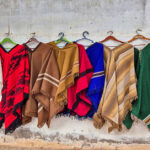The poncho is one of the world’s most versatile garments—simple in structure yet rich in cultural meaning, practical utility, and stylistic potential. Over thousands of years, the poncho has evolved from a functional shelter-like garment used by ancient Andean civilizations to a global fashion staple embraced for its comfort, adaptability, and artistic appeal. While the basic form of the poncho appears effortless, its influence extends deeply into cultural identity, historical storytelling, and modern design innovation. In this comprehensive guide, we explore the poncho’s origins, construction, materials, design variations, traditional roles, contemporary adaptations, outdoor uses, and place in modern fashion. We also examine the garment through practical perspectives including maintenance, buying considerations, and comparisons with similar outerwear.
A poncho is essentially a single large piece of fabric with an opening for the head, but that simplicity is what gives it an impressive range of uses. Historically, it protected individuals against cold winds, rain, and intense mountain weather, particularly in regions of South America. Today, however, ponchos appear everywhere—from luxury runways and bohemian streetwear to emergency rain gear carried by hikers and travelers. Understanding the poncho means appreciating its unique combination of cultural significance, clever design, and universal accessibility. This article will illuminate every aspect of this iconic garment in long, detailed sections.
Understanding What a Poncho Is
At its core, a poncho is an outer garment designed to drape over the shoulders and fall naturally around the wearer’s body. Traditional ponchos were crafted without sleeves, relying instead on their wide, loose form to provide warmth and mobility. Unlike jackets or sweaters, the poncho does not conform to the body; instead, it envelops it, creating a protective barrier against the elements. The structure is intentionally loose and adaptable, allowing a broad range of body types to wear it comfortably.
Ponchos typically come in two main categories: warm ponchos, usually made of wool or thick woven textiles for insulation, and rain ponchos, often using waterproof materials such as PVC or coated nylon to repel water. While these categories differ in purpose, they share the same fundamental design principles. This uncomplicated construction is one of the reasons the poncho has been adopted so widely across cultures and climates.
Historical Roots of the Poncho
The poncho’s history begins in the ancient Andes, particularly among Indigenous communities in modern-day Peru, Bolivia, Chile, and Argentina. Evidence of poncho-like garments appears in pre-Columbian textile traditions, where weaving was both a utilitarian and spiritual practice. The poncho’s rectangular shape made it ideal for weaving on traditional looms, and skilled artisans often incorporated symbolic patterns, geometric motifs, and colors that represented local beliefs, social status, or regional identity.
The garment was especially important in high-altitude regions where sudden weather changes and harsh climates demanded flexible protection. Because of its simplicity, the poncho could be made quickly when needed but also elaborated extensively for ceremonial purposes. Over time, poncho styles spread across South America, each region adding its distinctive features. For example:
Traditional Poncho Variations by Region
| Region | Traditional Material | Common Design Features | Cultural Significance |
|---|---|---|---|
| Andes (Peru/Bolivia) | Alpaca or llama wool | Bright colors, geometric symbols | Represents heritage, craftsmanship, local identity |
| Chile (Mapuche) | Sheep’s wool | Rich dark tones, bold stripes | Worn in rituals and daily life |
| Argentina | Wool or blended fibers | Long, heavy, warm | Used by gauchos for mobility and warmth |
| Mexico | Cotton or serape-style fabric | Vivid patterns, fringes | Symbol of Mexican cultural expression |
These variations illustrate how the poncho adapted to each culture’s environment, resources, and traditions. Despite differences, the underlying purpose remained consistent: warmth, protection, and identity.
Materials Used in Poncho Construction
The choice of material significantly influences how a poncho feels, performs, and appears. Over centuries, new materials have been integrated, expanding the poncho’s uses from traditional clothing to technical gear and high fashion.
Common Poncho Materials and Their Properties
| Material | Characteristics | Best Use |
|---|---|---|
| Wool | Warm, breathable, insulating | Cold weather, traditional wear |
| Alpaca | Soft, lightweight, luxurious | High-quality ponchos, cultural garments |
| Acrylic | Affordable, easy to clean | Casual fashion, everyday wear |
| Cotton | Comfortable, soft, natural | Light summer ponchos, layering pieces |
| Nylon | Lightweight, waterproof | Rain ponchos, travel gear |
| PVC | Fully waterproof, durable | Emergency and heavy-rain ponchos |
| Fleece | Warm, lightweight, cozy | Outdoor activities, casual layering |
Each material gives the poncho a distinct personality. Wool and alpaca connect the garment to its historical roots, while synthetic materials enable modern functionality such as water resistance and packability.
Types of Ponchos
As the poncho spread globally, it evolved into various forms suited for different purposes. Below are several key types that highlight the poncho’s versatility:
1. Traditional Andean Ponchos
Characterized by bold colors, handwoven textiles, and cultural symbolism, these ponchos serve both practical and ceremonial roles. They represent heritage, often passed down through generations.
2. Fashion Ponchos
Modern designers have embraced ponchos as stylish layering pieces. Fashion ponchos may include asymmetrical cuts, embellishments, buttons, or knitted patterns. They are worn to create a bohemian, elegant, or cozy aesthetic.
3. Rain Ponchos
Made from waterproof materials, rain ponchos are lightweight, often compact, and ideal for sudden storms. They are common among hikers, travelers, and outdoor workers.
4. Emergency Ponchos
These are extremely lightweight, usually made of thin plastic or reflective material. Emergency ponchos provide essential body heat retention in survival situations.
5. Outdoor and Camping Ponchos
Designed for versatility, some outdoor ponchos can double as a tarp, blanket, or shelter due to reinforced grommets and durable construction.
6. Hooded Ponchos
A modern adaptation where a hood is added for extra protection. Hooded ponchos appear in both fashion and outdoor categories.
The Poncho in Contemporary Fashion
Ponchos have been embraced as a stylish alternative to jackets and cardigans. Their effortless drape creates a relaxed yet polished look. Fashion designers appreciate the poncho for its dramatic silhouette and ability to layer over various outfits.
Some modern trends include:
- Oversized knit ponchos worn over leggings or skinny jeans
- Lightweight cotton ponchos used as beach cover-ups
- Elegant cape-style ponchos paired with formal outfits
- Ponchos with belts to create a defined waist
- Poncho sweaters that combine traditional knitwear with modern shapes
The fashion industry favors ponchos because they combine comfort, warmth, and artistic design freedom. Minimalist, bohemian, and high-fashion styles all have their own poncho variations.
Practical Uses of Ponchos Beyond Clothing
Ponchos serve multiple purposes beyond fashion or warmth. Outdoor enthusiasts value ponchos for their adaptability, especially during camping, hiking, and survival situations.
Outdoor Uses of Multi-Purpose Ponchos
| Use | Description |
|---|---|
| Rain shelter | Ponchos can be spread over branches or poles to create a quick shelter. |
| Ground cover | Used as a barrier against wet grass or dirt. |
| Emergency blanket | Reflective ponchos preserve body heat in survival situations. |
| Backpack protection | Oversized rain ponchos keep both body and backpack dry. |
| Shade cloth | Lightweight ponchos can block harsh sunlight in outdoor settings. |
This multipurpose nature makes ponchos essential tools for adventurers who need compact but effective protection.
Poncho vs. Similar Garments
Ponchos are often compared to other garments, but each has distinct differences.
Poncho vs. Cape
- Ponchos generally have a head opening; capes do not.
- Capes may fasten at the neck, while ponchos drape freely.
- Capes are more theatrical and symbolic in design.
Poncho vs. Shawl
- Shawls are rectangular or triangular pieces wrapped around the shoulders.
- Ponchos are worn over the head for more full-body coverage.
Poncho vs. Cloak
- Cloaks are often floor-length and designed for warmth or ceremonial dress.
- Ponchos are usually waist- to thigh-length and more practical for daily use.
Understanding these distinctions helps clarify the poncho’s unique structure and purpose.
How to Choose the Right Poncho
Selecting a poncho involves considering the intended use, climate, material preference, and personal style. Here are key factors to evaluate:
1. Material
Choose wool or alpaca for warmth, cotton for comfort, and nylon or PVC for rain.
2. Fit and Length
Long ponchos provide extra warmth, while shorter ponchos allow more mobility.
3. Purpose
- For fashion, focus on design details such as patterns or fringe.
- For travel, prioritize lightweight and packable materials.
- For outdoor use, consider waterproof or multi-purpose ponchos.
4. Durability
Stitching quality, fabric strength, and maintenance requirements matter, especially for outdoor ponchos.
5. Cultural Authenticity
When purchasing traditional ponchos, supporting artisans helps preserve ancient textile traditions.
Caring for Your Poncho
Maintenance depends on the material. Wool ponchos require gentle cleaning to preserve their fibers, while synthetic ponchos are often washable and durable.
Poncho Care Guide
| Material | Care Method |
|---|---|
| Wool/Alpaca | Hand wash in cold water, air dry, avoid heat |
| Cotton | Machine wash gently, tumble dry low |
| Acrylic | Machine wash, retains color and shape |
| Nylon | Wipe clean or machine wash, dries fast |
| PVC | Clean with a damp cloth, avoid folding for long periods |
Proper care extends the lifespan of the poncho and maintains its appearance.
The Cultural and Artistic Significance of Ponchos
In Indigenous cultures, ponchos represent far more than outerwear. Many ponchos serve as artistic canvases, telling stories through patterns, borders, and woven symbols. Colors may represent elements such as land, mountains, sky, community, or spiritual beliefs. Poncho-making is an honored craft passed down over generations, with artisans using traditional looms and natural dyes to create meaningful textiles. Wearing a traditional poncho can signify respect for heritage and acknowledgment of cultural artistry.
Conclusion
The poncho stands as a remarkable garment because of its universal appeal, diverse functions, and deep cultural roots. From ancient Andean civilizations to modern designers and outdoor enthusiasts, people across the world appreciate the poncho for its simplicity, adaptability, and expressive potential. It is a garment that bridges history and modernity, practicality and artistry, tradition and innovation. Whether used for warmth, style, protection, or cultural expression, the poncho continues to evolve, proving its enduring value in a rapidly changing world. Understanding its history, materials, styles, and uses allows us to appreciate this iconic garment on a deeper level, recognizing it not just as clothing but as a representation of human creativity and resilience.
FAQs
1. What is the main purpose of a poncho?
A poncho’s primary purpose is to provide protection from cold, wind, or rain. Its loose design makes it easy to wear over other clothing, making it suitable for both fashion and outdoor uses.
2. Are ponchos good for hiking or outdoor activities?
Yes. Rain ponchos and multipurpose outdoor ponchos are excellent for hiking because they are lightweight, packable, and capable of covering both the wearer and their backpack during sudden weather changes.
3. What materials are best for a warm poncho?
Wool, alpaca, and fleece are ideal for warm ponchos because they provide excellent insulation while remaining breathable and comfortable.
4. Can ponchos be worn as everyday fashion?
Absolutely. Many ponchos are designed for casual or stylish wear, offering comfortable layering and a relaxed yet polished look for daily outfits.
5. How should I wash a wool poncho?
Wool ponchos should be hand washed in cold water using mild detergent, then air dried. Avoid heat or machine drying to preserve the fibers.











